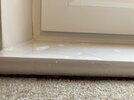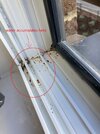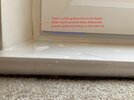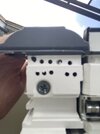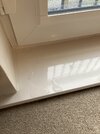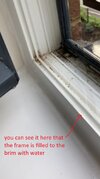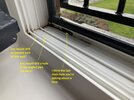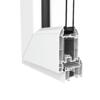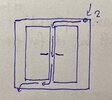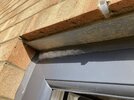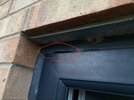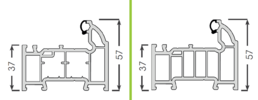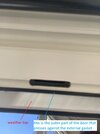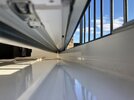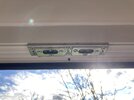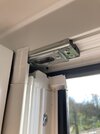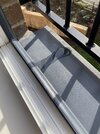Hi all,
I would really appreciate your help please. I've been struggling with this issue for a whole year now. There's still no resolution, and the stress is starting to affect my day-to-day life. The manufacturer is completely useless (although pretends otherwise to save face), but they have no idea what's going on, they've been trying to fix it for a year, but nothing has worked. (Well, "trying" is a strong word, they visibly don't care, even though I'm still well within my warranty period, which just adds to my frustration.)
I'm in a flat on the 3rd floor, south facing, with French doors (opening inwards) and a Parisian balcony. The building is just a year old.
Rainwater seems to accumulate in the bottom left corner of the door frame, and instead of flowing towards the clean and functioning drain holes, it flows inwards, onto the inner sill, then onto my carpet. Photos attached.
The cross-section of the door frame has these thresholds/dams with valleys between them (apologies for not knowing the technical words), the outer one has the drain holes, and the innermost/thinnest one seems to hold water, which then accumulates in the bottom left corner and ends up in my flat. I have no idea how a tight door against the frame means less resistance for the water than climbing a couple of small thresholds towards the drain hole.
Any help would be much appreciated. Will of course provide more info if needed.
Thank you,
Matt
P.S.
This is what has been tried before:
-- Doors were tightened against the frame.
-- Weather bars have been installed.
-- Silicone around the top and bottom mullion caps. -- this was 31 May 2024
-- Small holes were drilled into the bottom mullion cap -- photo attached. (There was water in the bottom mullion cap, so the manufacturer's engineer drilled some holes in it to let the water drain out. (In my unprofessional opinion, there's already something fishy going on here, please let me know whether you think my concern is justified, or this is normal practice.) Before this, the leak was in the middle, where the two doors meet. After this, the leak was only in the bottom left corner of the frame. My suspicion is that the water draining out of the bottom mullion cap travels along the bottom frame and accumulates in the left corner. But it is still beyond me why it's easier for the water to get through a tightly closed door than to get across two small thresholds towards the drain hole. Is it at all possible to drill a few similar holes into the door frame where the water accumulates in such a way that it will connect into the regular channel of the drain hole?) -- this was 31 May 2024 as well
-- Nest packers have been swapped on the affected door, so the door now squeezes even more tightly against the frame. -- this was 20 Feb 2025 (and the latest leak that I'm talking about now was today, 23 Feb 2025)
I would really appreciate your help please. I've been struggling with this issue for a whole year now. There's still no resolution, and the stress is starting to affect my day-to-day life. The manufacturer is completely useless (although pretends otherwise to save face), but they have no idea what's going on, they've been trying to fix it for a year, but nothing has worked. (Well, "trying" is a strong word, they visibly don't care, even though I'm still well within my warranty period, which just adds to my frustration.)
I'm in a flat on the 3rd floor, south facing, with French doors (opening inwards) and a Parisian balcony. The building is just a year old.
Rainwater seems to accumulate in the bottom left corner of the door frame, and instead of flowing towards the clean and functioning drain holes, it flows inwards, onto the inner sill, then onto my carpet. Photos attached.
The cross-section of the door frame has these thresholds/dams with valleys between them (apologies for not knowing the technical words), the outer one has the drain holes, and the innermost/thinnest one seems to hold water, which then accumulates in the bottom left corner and ends up in my flat. I have no idea how a tight door against the frame means less resistance for the water than climbing a couple of small thresholds towards the drain hole.
Any help would be much appreciated. Will of course provide more info if needed.
Thank you,
Matt
P.S.
This is what has been tried before:
-- Doors were tightened against the frame.
-- Weather bars have been installed.
-- Silicone around the top and bottom mullion caps. -- this was 31 May 2024
-- Small holes were drilled into the bottom mullion cap -- photo attached. (There was water in the bottom mullion cap, so the manufacturer's engineer drilled some holes in it to let the water drain out. (In my unprofessional opinion, there's already something fishy going on here, please let me know whether you think my concern is justified, or this is normal practice.) Before this, the leak was in the middle, where the two doors meet. After this, the leak was only in the bottom left corner of the frame. My suspicion is that the water draining out of the bottom mullion cap travels along the bottom frame and accumulates in the left corner. But it is still beyond me why it's easier for the water to get through a tightly closed door than to get across two small thresholds towards the drain hole. Is it at all possible to drill a few similar holes into the door frame where the water accumulates in such a way that it will connect into the regular channel of the drain hole?) -- this was 31 May 2024 as well
-- Nest packers have been swapped on the affected door, so the door now squeezes even more tightly against the frame. -- this was 20 Feb 2025 (and the latest leak that I'm talking about now was today, 23 Feb 2025)


